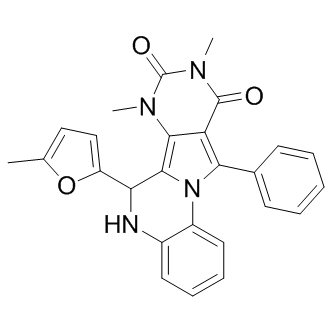| In Vitro: |
The most potent compound, 7,9-dimethyl-11-phenyl-6-(5-methylfuran-2-yl)-5,6-dihydro-pyrimido[4',5'-3,4]pyrrolo[1,2-a]quinoxaline-8,10-(7H,9H)-dione, PPQ-102, completely inhibited CFTR chloride current with IC(50) approximately 90 nM. The PPQs, unlike prior CFTR inhibitors, are uncharged at physiological pH, and therefore not subject to membrane potential-dependent cellular partitioning or block efficiency. Patch-clamp analysis confirmed voltage-independent CFTR inhibition by PPQ-102 and showed stabilization of the channel closed state [1]. The three gpSlc26 anion transporters exhibited distinct pharmacological profiles of (36)Cl(-) influx, including partial sensitivity to CFTR inhibitors Inh-172 and GlyH101, but only Slc26a11 was inhibited by PPQ-102 [2]. Airway epithelial NCI-H292 cells and primary cultures of noncystic fibrosis human airway epithelial cells were treated with cystic fibrosis transmembrane conductance regulator (CFTR) inhibitors (CFTR-inh(172) or PPQ-102) or transfected with a CFTR small interfering (si)RNA with or without a selective epidermal growth factor receptor tyrosine kinase inhibitor [3]. |






















